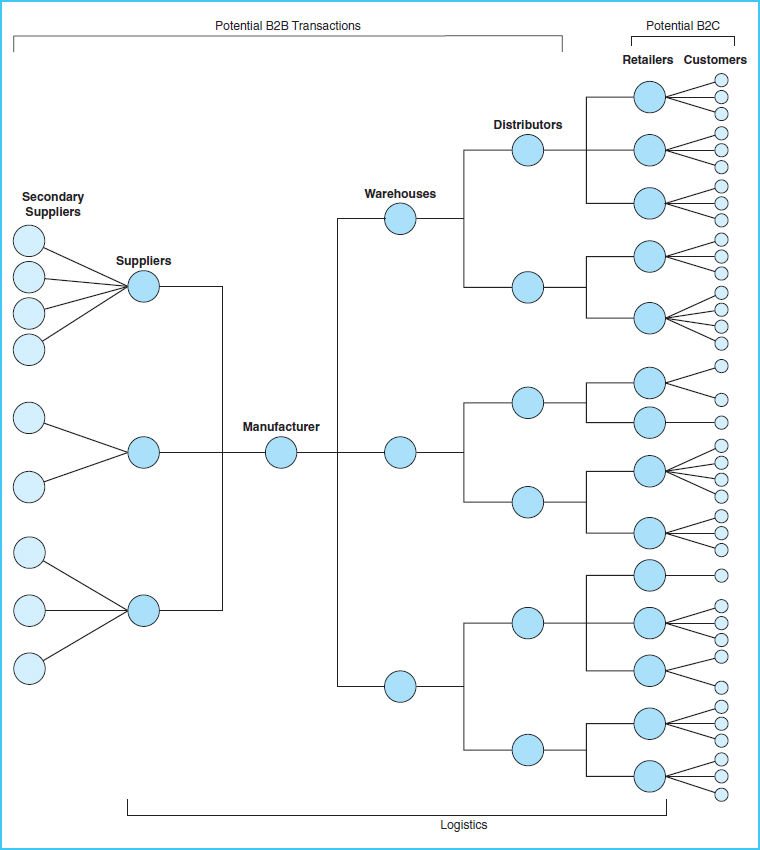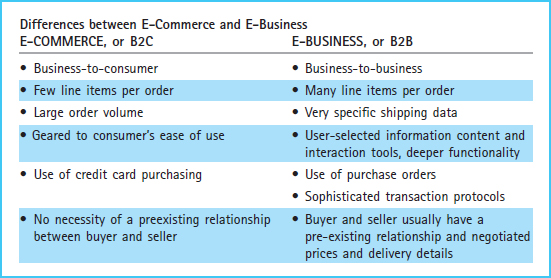E-BUSINESS AND IT ENABLEMENT (STUDY OBJECTIVE 6)
As discussed previously, e-business is a very broad, encompassing term for the electronic enabling of business processes. The business processes enabled by IT systems can be internal and external. Examples of internal processes are the movement of raw materials within a company, the timekeeping and labor management of workers, the dissemination of employee information such as health and retirement benefits, and the sharing of data files among workers. These types of internal processes can be streamlined and enhanced by incorporating electronic forms of these processes through the use of IT systems. Likewise, there are many external business processes that can be streamlined and enhanced through the use of IT systems. For example, the processes that involve suppliers and distributors can be streamlined, enhanced, and improved by the use of IT systems.
The supply chain is the set of linked processes that take place from the acquisition and delivery of raw materials, through the manufacturing, distribution, wholesale, and delivery of the product to the customer. The supply chain includes vendors; manufacturing facilities; logistics providers; internal distribution centers such as warehouses, distributors, and wholesalers; and any other entities that are involved, up to the final customer. In some cases, the supply is larger at both ends because it can include secondary suppliers to the company's suppliers and the customers of the company's immediate customers. Exhibit 14-5 illustrates the entities in a sample supply chain for a manufacturer and the relationships between those entities. Service firms have a less complex supply chain.
To gain an understanding of the supply chain, it may be helpful to begin in the middle of the exhibit. A manufacturer makes products. Upon completion of the manufacturing, the finished products are sent to and stored in warehouses. As those products are needed, they are shipped to distributors or wholesalers. The distributors or wholesalers eventually ship the products to retail companies, and the retail companies sell the products to end-user consumers.
However, before a manufacturing company can produce products, it must buy the raw materials that are the ingredients of the products. For example, a wine maker must buy grapes. In some instances, a manufacturing company's supply chain may include secondary suppliers. For example, a company that manufactures personal computers (PCs) may buy components such as graphics cards from a supplier. The supplier, however, makes the graphics cards after buying chips and circuit boards from secondary suppliers. While there may not be direct exchanges between the manufacturer (maker of the PC) and the secondary supplier's (the chip maker), the secondary supplier's performance and product quality have a dramatic effect on the manufacturer. For example, if the chip maker runs out of chips, the graphics card maker is prevented from making graphics cards on time, which thereby makes the PC maker unable to make and ship PCs. Similarly, poor quality chip production by the chip maker affects the quality of the graphics board, and therefore the quality of the PC.
This interdependency of entities in the supply chain means that companies should be interested in enhancing and streamlining the processes and exchanges that occur throughout the supply chain. Poor quality, slow performance, or a process bottleneck anywhere in the supply chain affects other parts of the supply chain. There is an old saying that a chain is only as strong as the weakest link. Similarly, a supply chain is only as efficient as its weakest, or most inefficient, link.

Exhibit 14-5 The Supply Chain for a Manufacturing Company
Many interactions between entities and many business processes must occur to complete the steps that result in raw materials being converted into products and eventually sold to the customer. Any of these processes or linkages between entities can be enabled or enhanced by the use of IT systems. Any that are enabled by IT become a part of e-business. This view of the supply chain shows how broad the scope of e-business is in comparison with e-commerce. E-commerce, or B2C sales, includes only the extreme right-hand part of the diagram in Exhibit 14-5, when the sale is between a company and the end-user customer. E-business includes the entire supply chain, and there is overlap between e-business and e-commerce. E-commerce is a subset of e-business.
Some companies may choose to be involved in many parts of their supply chain. For example, a vertically integrated company may have its own related subsidiaries so that each of the interactions within the supply chain is owned or controlled by the larger corporate entity. Vertical integration occurs when a single company owns all of the entities that make up the supply chain, from the movement of raw materials to the delivery of the finished product to the customer.
Other companies may choose to focus on only a small part of the supply chain. For example, a company could choose to do only the manufacturing portion of the supply chain; all other entities within the supply chain, such as suppliers, distributors, wholesalers, and retailers, are separate companies. These differing levels of integration within the supply chain mean that the processes which occur within a supply chain may be internal to a company or may involve exchanges with external companies. In either case, internal or external, those processes and exchanges can be streamlined or enhanced through e-business.
The “Logistics” label in Exhibit 14-5 illustrates that there are entities within the supply chain whose function is to provide the physical support that moves materials and goods between parts of the supply chain. For example, a manufacturer must have a means of moving raw materials from the supplier to the plant and of moving finished goods from the plant to the warehouse and distributor. Logistics are the types of services provided by entities such as trucking companies, air and rail freight companies, and freight expediting companies.
Any of the interactions between the entities within the supply chain can be a point at which e-business can be applied to streamline or reduce costs. The next section describes a smaller subset of e-business interactions within the supply chain: B2B, or business-to-business electronic transactions.
B2B: A PART OF E-BUSINESS
B2B is the sale of products or services between a business buyer and a business seller that is electronically enabled by the Internet. In B2B sales, neither buyer nor seller is an end-user consumer. Much of what you studied in Chapters 8 through 12 were e-business processes. For example, sales between businesses occur through EDI or EDIINT; shipments and inventory can be tracked using RFID; billing and payment occur through Electronic Invoice Presentment and Payment (EIPP). All of these are examples of IT enablement that enhance, streamline, and reduce the cost of business-to-business transactions. Although there are many ways to conduct business electronically between businesses, this chapter focuses on Internet based e-business. As in the case of e-commerce, both parties benefit from the increased access to the market, the speed and convenience of e-business, and ability to share information. There are also many differences between B2C and B2B transactions, as illustrated in Exhibit 14-6. When comparing B2B with B2C, B2B has the following differing characteristics:
Exhibit 14-6 E-commerce B2C vs. E-Business B2B3

- The transaction or exchange is between businesses.
- The order would have many line items, and the dollar amount of each sale is usually large.
- While a B2C sale might be a single book purchased from Amazon, a B2B sale might be tons of raw materials, as in the case of grapes to make wine. The B2B sale will have specific shipping details such as type of carrier used, delivery dates, and locations of delivery to different plants within the company.
- The B2B transaction can involve electronic forms of standard business documents such as purchase order and invoice.
- The B2C transaction is between the company and any potential customer on the Internet. There need not be any preexisting relationship. The B2B transaction is between buyer and supplier, and the parties usually have a preexisting relationship. The buyer knows which suppliers it will use, and the supplier knows that the buyer will be buying raw materials or services. The buyer and supplier would have already negotiated many of the details of the transaction, such as prices, discounts, payment terms, credit limits, delivery dates, and locations of delivery.
When conducted via the Internet, B2B transactions between supplier and buyer offer many advantages to both parties. Many of the advantages are similar to those described in the e-commerce section of this chapter. Internet-based transactions offer a wider potential market, reduced transaction cost, and higher profits. B2B will also result in faster cycle times for the purchases from suppliers. The cycle time is the time from the placement of an order for goods to the receipt of, and payment for, the goods. The faster cycle time results from the increased efficiency of processing transactions via the Internet. In B2B transactions between suppliers and buyers, the two IT systems exchange data through the Internet network. The Internet allows companies to reduce or eliminate manually keying the order into the computer system, mailing documents to initiate the order, entering receipt of goods, and keying in documents to initiate payment. The fact that the two IT systems communicate eliminates data errors, since data may no longer be manually keyed into the system.
